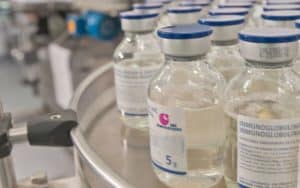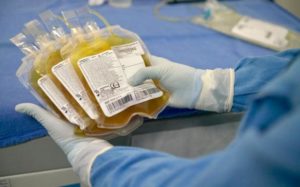CONTACT
We will reply as soon as possible.
Enevia Health, LLC
30 N Gould Ste N, Sheridan, WY 82801, USA
IVIG is a blood product purified from a pool of human plasma obtained from healthy donors composed of a relatively pure concentrate of human polyclonal IgG (90%-98% IgG) with a distribution of IgG subclasses similar to that of the serum (IgG1 60%-70%, IgG2 20-30%, IgG3 0%-6%, IgG4 0%-4%).
Commercial preparations also contain a small amount of IgA, IgE and IgM, manufacturing products and other serum proteins, such as traces of soluble CD4, CD8, HLA molecules and cytokines.
The number of donors recommended by the FDA to contribute to the human plasma pool that will be used to obtain an IVIG preparation ranges from 15,000 to 60,000. As blood is a potential source of pathogens for the recipient, procedures are carried out during the donor selection and manufacturing processes that reduce this risk. To date there are no reports of transmission of HIV, Creutzfeldt-Jakob disease or HBV.

In the mid-1990s, a focus of HCV infection was detected with the use of IVIG; This product was withdrawn from the market and since then no new cases have been reported. IVIG products can be liquid or lyophilized powder, and in addition to these different presentations there are different final concentrations of the product that vary between 3%, 5%, 6%, 10% or 12%, the most used being 5% (5 g/100 ml ) and 10% (10 g/100 ml).
Replacement therapy indicated for primary or secondary immunodeficiencies with the objective of providing an adequate level of antibodies that confer protection against infectious diseases.
The recommended dose is 400-600 mg/kg every three-four weeks. Initial IVIG infusions are generally started at a slow rate, accelerating every 15 minutes and then progressively. For the first therapy, start with an infusion rate of 0.5 to 1 mg/kg/min. After 15 to 30 minutes, increase the drip twice as tolerated, until reaching a maximum dose of 4 mg/kg/min.
Subsequent infusions can be started at 2 mg/kg/min and every 30 minutes increase the dose to a maximum of 8 mg/kg/min. In practice, before starting therapy and every 12 months one should evaluate liver function, kidney function, perform a complete blood count, chest x-ray and request an immunoglobulin count in order to exclude an IgA deficiency or other clinical condition. relevant patient that could modify the IVIG preparation to be used or its method of administration or its clinical response.
The day before the infusion, the IgG concentration must be determined, for at least six months. When two consecutive determinations show an IgG level greater than 500 mg/dL, the monthly controls are suspended, continuing with one every three to six months. The goals of treatment are to achieve a serum IgG count above 500 mg/dL in patients with agammaglobulinemia or 350 mg/dL above pretreatment levels in patients with common variable immunodeficiency.

Immunomodulatory dose The dose of IVIG needed to control autoimmune diseases is three to five times higher than replacement doses; 2 g/kg of IVIG administered every four to six weeks has shown anti-inflammatory effects. This dose can be infused over five days (400 mg/kg); However, studies show a greater effect if administered as a single complete dose given in one or two days.
Route of administration The use of IVIG has numerous advantages when compared to its equivalent intramuscular administration; On the one hand, it allows high doses to be administered (up to 2 g/kg), it rapidly increases plasma IgG levels, has a faster onset of action, and its administration does not induce pain.
However, it must be administered in a hospital setting. Subcutaneous administration (SCIG) is an alternative to intravenous use in patients with immunodeficiency. It has the advantage of being a simple technique, without reported severe adverse effects, well tolerated and that improves the quality of life of patients, since it is self-administered at home on a weekly basis. Comparative studies do not show a difference in the efficacy of IVIG and SCIG at replacement doses.
Adverse effects IVIG therapy is relatively safe, adverse effects range between 5% -10% of patients and in most cases are mild.
The different commercial IVIG products differ greatly in their excipients, which has clinical implications, specifically in the development of adverse effects.
Characteristics of the IVIG formulation that alter tolerability include volume administered, infusion rate, osmolarity, pH, sodium content, and sugar content.
Patient characteristics that affect tolerability are diabetes mellitus, age over 65 years and previous nephropathy, among others. Headache, fever, chills, myalgia, arthralgia, nausea, vomiting, abdominal pain, flushing, bronchospasm, urticaria and variations in blood pressure and tachycardia are mild adverse effects that are associated with the administration of IVIG and are secondary to the possible addition of IgG, formation of immune complexes and subsequent complement activation or, in some cases, secondary to the sugar content of the preparation.
Generally these alterations are transient and appear with the first administration, during the first hour of infusion. In most cases, it is enough to reduce the infusion rate or suspend it for 15 to 30 minutes to reverse the symptoms.
The administration of corticosteroids, antihistamines or NSAIDs prior to the infusion reduces the risk of occurrence. Severe adverse effects are occasional and their appearance occurs mainly in patients who have risk factors that predispose their appearance when using certain IVIG preparations that contain manufacturing products at high concentrations.
The main ones are listed below:
DVT, PE, and central retinal vein thrombosis have been reported in patients following IVIG infusion, especially in patients with a prior history of thrombosis or in the setting of immobilization. Numerous studies associate these reactions with the incipients of IVIG, especially with the presence of activated factor XI.
Anaphylaxis is a rare reaction that is mainly seen in patients with IgA deficiency, due to anti-IgA antibodies that react with the IgA of the IVIG preparation and the subsequent activation of complement. Its appearance can be prevented if IVIG refolded in IgA is used.

Since all commercial IVIG preparations come from human plasma, there is a risk of transmitting infectious diseases. Currently this occurs with a very low frequency given the modern techniques for obtaining the preparations and the infectious screening carried out on donors.
Anti-infective mechanisms: Regarding anti-infective mechanisms, it has been seen that the role of IVIG in preventing infections in patients with immunodeficiency is through the restoration of the levels of both pathogen-specific and natural antibodies; This leads to the development of a normal humoral immune response against noxa.
Immunomodulatory and anti-inflammatory mechanism: In order to understand the modulatory and anti-inflammatory function of IVIG, it is important to remember that its content is not only IgG with a wide spectrum of specificities, but also contains a small amount of other plasma components that can play an immunomodulatory role.
Natural antibodies (Ab): They are mainly IgM Abs that arise under physiological conditions without the need for prior contact with the antigen and are part of the innate immune system.
The content of natural antibodies in IVIG is believed to confer an important anti-inflammatory role to IVIG, which probably involves Fc region-dependent mechanisms and/or F(ab)2 region-dependent mechanisms.
These antibodies can be self-reactive, but not self-specific, and their possible role “in breaking” immunological tolerance is in favor of the control of physiological autoreactivity.
Neutralization of autoantibodies: IVIG contains natural antibodies directed against the idiotype (Fab variable region) of pathogenic autoantibodies.
These are called antiidiotype antibodies and prevent binding to self-antigens. In vitro studies show that antiidiotype antibodies bind to the variable region of antigen receptors, preventing their activation by autoantigens.
Binding to the antigen receptor and the immunoglobulin FcγIIb receptor: Activates the B cell inhibitory pathway by specifically blocking the proliferation of autoreactive B cells.
All of these mechanisms together allow us to understand the effects of IVIG in reducing the effects of autoantibodies and their titers.
Modulation of cytokine production: Healthy people have natural antibodies against various proinflammatory cytokines, such as IL-6, IL-1, TNFα, IL-8, GM-CSF, among others, so it is not uncommon to find antibodies against cytokines in IVIG preparations and show its anti-inflammatory role by neutralizing its effect.
Furthermore, IVIG induces a modulation in the production of proinflammatory cytokines by monocytes, macrophages and CD4 lymphocytes associated with a selective elevation of the IL-1 receptor antagonist (IL-ra). Modulation in the production of cytokines and cytokine antagonists is the most important anti-inflammatory mechanism of IVIG.
Complement inhibition: The constant portion (Fc) of the IgG of IVIG preparations can bind to the C3b and C4b fragments of complement in a C1q-independent form, preventing their deposition in the tissues and consequent damage.)
Additionally, the presence of natural antibodies against C3b and another mechanism of neutralization of anaphyllotoxins C3a and C5a through the F(ab)2 region of IgG have been demonstrated.
Activation or functional blockade of the cell death receptor (Fas or CD 95): There is evidence of IVIG in the inhibition and promotion of cell death mediated by the Fas molecule. IVIGs contain natural antibodies to Fas epitopes; Some of these antibodies are IgG and have an antagonistic function and block the interaction of the Fas molecule with its ligand (FasL) that produces apoptosis.
Binding to other cell membrane molecules: IVIG may contain antibodies against cytokine receptors, CD5, CD4, MHC I, CCR5 and CD40, which could have an immunomodulatory effect by affecting the interaction of these functional lymphocyte molecules with their ligands. Furthermore, it is necessary to remember that IVIG contains other proteins such as traces of soluble MHC I, CD 4 and CD 8 that would exert an immunomodulatory effect by blocking autoantigens.
Effect mediated by the Fc region of IVIG: The Fc region of IgG interacts with its receptor FcγR in hematopoietic cells. There are FcγR receptors that perform activating or inhibitory functions by stimulating different intracellular signaling pathways, depending on the presence of the ITAM (activator) or ITIM (inhibitor) domain in the cytoplasmic tail of the receptor.
Competitive blockade of FcγR receptors in macrophages prevents the clearance of sensitized cells by the reticuloendothelial system and is considered the key mechanism of IVIG in the control of ITP and other antibody-mediated cytopenias.
Recent studies indicate that IVIG increases the expression of the FcγRIIb receptor (inhibitory), preventing the clearance of opsonized platelets and inducing inhibition of autoreactive B cells and a decrease in the production of autoantibodies when the BCR is simultaneously activated.
Effect on dendritic cells (DC): Contrary to what happened with replacement doses of IVIG, high doses of IVIG alter the differentiation and maturation of DC in vitro, inducing a regulatory phenotype, decreasing their ability to secrete IL-12 and increasing the secretion of IL-10.
Furthermore, it has been observed that IVIG induces a down-regulation of costimulatory molecules.
Effects on T and B lymphocytes: It has been observed that IVIG inhibits the proliferation and secretion of IgE in B cells activated by CD40 in vitro, and also reduces the expansion of B lymphocytes activated by CD40 in the presence of cytokines.
In murine models, IVIG induces a downregulation of autoreactive B cells by simultaneously stimulating the BCR and FcγRIIb).
Regarding T lymphocytes, antiidiotype antibodies have been detected that are capable of binding to the variable region of the TCR, blocking its activation by autoantigens.
Initially IVIG was used as replacement therapy in patients with immunodeficiencies; Currently, its use has been expanded to a large number of autoimmune diseases and systemic inflammatory disorders. FDA-approved indications for use are listed below:
1. Primary immunodeficiencies: Its regular use has shown benefits in immune disorders that compromise B and T cells and in combined immunodeficiencies by reducing the number of acute and chronic infectious episodes, as well as their long-term complications and sequelae.
Selective IgA deficiency is not an indication for IVIG, but on some occasions this entity coexists with specific antibody deficiency with or without IgG2 deficiency; In these cases, IVIG is indicated, but those preparations do not contain IgA in order to prevent sensitization and subsequent anaphylaxis due to the presence of IgE anti-IgA antibodies.
2. Secondary immunodeficiencies: Chronic Lymphocytic Leukemia (CLL), pediatric HIV and bone marrow transplantation.
3.PTI: The indication to start therapy in the pediatric population is the presence of severe bleeding and in those children with a platelet count less than 20,000. In adults, the indication to start therapy is the presence of severe bleeding associated with a platelet count of less than 20,000.
4. Kawasaki Disease (KD): The use in the first 10 days of the onset of febrile symptoms of IVIG at a dose of 2 g/kg associated with aspirin prevents the development of coronary aneurysms, in addition to a clinical improvement that is manifested with a reduction in fever and neutrophil count. and acute phase reactants in the first 24 hours of treatment.
5. Other uses: Although the uses approved by the FDA are restricted, it is known that in most cases it is used for unlicensed pathologies. Hematological and neurological causes are the main causes of IVIG prescription. Within the group of neurological diseases, chronic inflammatory demyelinating polyneuropathy, Guillain-Barré syndrome and multifocal motor neuropathy stand out as entities that definitely benefit from its administration.
The use of IVIG as adjuvant therapy in bacterial sepsis or septic shock has significantly reduced mortality, however, in order to make an indication in this field, further study is necessary.
The only absolute contraindication to IVIG administration is a history of anaphylactic reaction with IVIG or another blood product.
Since its first use in replacement therapy in patients with agammaglobulinemia, IVIG has shown therapeutic usefulness in numerous diseases, however its usefulness has been poorly documented since there are few randomized double-blind placebo-controlled studies that allow establishing this medication as a therapeutic indication. .
During recent years, its use has increased, largely thanks to advances in the manufacturing processes of commercial products that make it a safe medicine, greater understanding of its mechanisms of action and the low rate of adverse reactions associated with it. its use.

However, it is a medication with a high cost and whose effectiveness in some pathologies is not well defined. The mechanisms of action are complex and involve anti-infective and anti-inflammatory/immunomodulatory mechanisms.
Additional research is required to more accurately understand the most important mechanisms of action in in vivo models associated with a greater understanding of the pathophysiology of the disease in order to more accurately select the patients who will truly benefit from its use.
Article source: https://sochire.cl/wp-content/uploads/2021/09/r-398-1-1343744482.pdf.
If you are interested in the topic of intravenous immunoglobulin, we have other related articles, we leave them below:
Treatment with IVIG improves neuropsychiatric symptoms in patients with PANS
VIRUSES and their role in my daughter's ASD symptoms: The case of Matilde (Part 2)
We will reply as soon as possible.
30 N Gould Ste N, Sheridan, WY 82801, USA
Our groups are the ideal platform to learn and share your scientific concerns about neurodevelopment issues
*Our purpose is informational only, it is not intended to be a substitute for medical advice, diagnosis or treatment.
We are working on our website. For any queries, you can contact our customer service team at atencionalcliente@eneviahealth.com